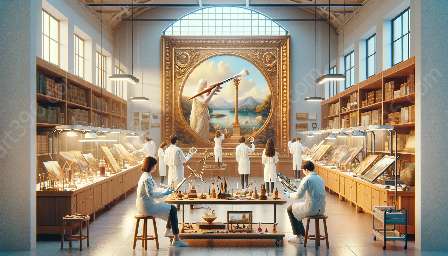Metal objects have long been cherished for their historical, artistic, and cultural significance. Preserving these objects requires careful and strategic conservation practices. In this article, we will explore the comparison between traditional conservation techniques and innovative contemporary approaches for metal object conservation, considering their impact on art conservation.
Defining Traditional Conservation Practices
Traditional conservation practices for metal objects are often rooted in time-tested methods passed down through generations. These practices may include surface cleaning, corrosion removal, and protective coatings using materials and techniques that have proven effective over time. Furthermore, traditional methods often involve a high level of manual labor and craft-based expertise, emphasizing a deep understanding of material properties and historical context.
The Evolution of Contemporary Approaches
In recent years, innovative contemporary approaches to metal object conservation have emerged, harnessing cutting-edge technology and scientific advancements. These approaches may involve non-invasive imaging techniques, such as X-ray fluorescence, to analyze material composition and degradation, as well as 3D mapping and printing for creating precise replicas and customized supportive structures. Additionally, the use of advanced chemical treatments and nanomaterials has become more prevalent, offering tailored solutions to complex conservation challenges.
Comparing Effectiveness and Longevity
When comparing traditional and innovative conservation practices, it is essential to consider their effectiveness and longevity. Traditional techniques, honed over centuries, have proven to be reliable for preserving metal objects. The intimate knowledge of materials and craftsmanship involved in traditional practices contributes to long-lasting conservation results. On the other hand, innovative approaches, while leveraging state-of-the-art tools and materials, may require ongoing validation of their long-term impact and sustainability to ensure they stand the test of time.
Impact on Art Conservation
The choice between traditional and innovative conservation methods can significantly impact art conservation as a whole. Traditional practices often emphasize the preservation of historical authenticity and cultural heritage, acknowledging the value of original craftsmanship and patina. On the contrary, contemporary approaches may prioritize scientific accuracy and potential reversibility, aiming to push the boundaries of conservation possibilities while adapting to evolving standards and understanding of material science.
Integration of Traditional and Contemporary Approaches
Recognizing the strengths of both traditional and contemporary approaches, some conservation professionals advocate for an integrated approach that harmonizes time-tested methods with modern innovations. By combining the deep-rooted knowledge of traditional practices with the precision and efficiency of contemporary technologies, conservators can create holistic conservation strategies that prioritize both authenticity and scientific rigor.
Conclusion
In conclusion, the comparison between traditional conservation practices and innovative contemporary approaches for metal object conservation is an intriguing and ongoing discourse in the field of art conservation. While traditional practices remain fundamental for their historical significance and proven reliability, innovative approaches offer exciting possibilities for advancing conservation science. Ultimately, the integration of these approaches holds the potential to elevate the field of metal object conservation, ensuring the preservation of our cultural heritage for generations to come.

